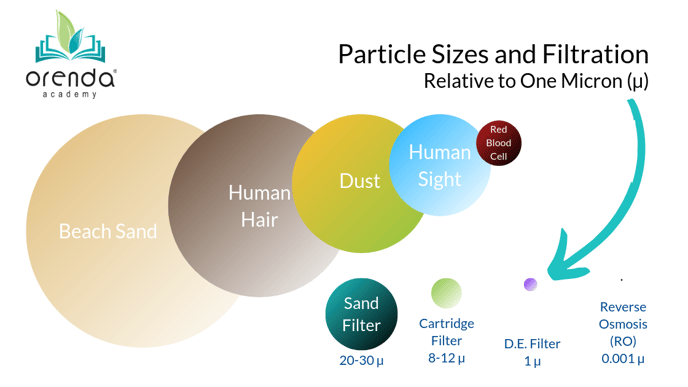What is Reverse Osmosis (RO) Filtration?
Reverse Osmosis (RO) is an ultra-fine water filtering technique that can remove just about anything from water.
If you are unable to drain a swimming pool, but need to reduce chemistry factors like Cyanuric Acid (CYA) and Total Dissolved Solids (TDS), Reverse Osmosis (RO) will filter them out.
Unlike normal pool filters, RO can remove contaminants as small as single-cell bacteria and viruses, and dissolved solids like salts and metals.

The best (smallest) screening ability of any pool filter we know of is from a D.E. filter, which is capable of screening down to just one micron (1 µ). But reverse osmosis systems can screen particles 1,000 times smaller than that, at just 0.001 of a micron!
Here are some great explainer videos of how RO filtration works:
RO membrane
The key to successful RO filtration is the quality of the membrane that water is forced to flow through. This membrane is so fine that only pure water (H2O) can pass through it. Everything else is left behind.
There are three layers to an RO membrane, per the video above:
- Polyamide layer (ultra-fine)
- Polysulfone layer (which reinforces the ultra-thin polyamide layer)
- Polyester base
Because an RO membrane has such incredible screening ability, it should quickly get clogged, right? Actually not. RO systems use a clever coiling system where water passes linearly across the membrane, not immediately forced through the membrane. This allows more contact with the membrane. Through hydraulic pressure, pure water is pushed through the membrane while the rest of the contaminants continue moving to a waste line (sometimes called the "concentrate" line).
Eventually, yes, membranes will get clogged. But the concentrate line allows for most of the undesired particles to continue flowing until they exit the system through a waste line. This waste line usually accounts for about 10-25% of the volume of water treated...so for a swimming pool, you will need to add replacement water when the RO process is done.
Keeping the membranes clean
One thing that DOES clog RO membranes is non-living organics and oils. In our experience with swimming pool RO companies, membranes get fouled quickly if the pool is loaded with organics and hydrocarbons like sunscreen, lotions, and other gunk. Unlike dissolved solids, oils and other non-living organics stick to the RO membrane, as opposed to simply not being allowed to pass through and then flowing out through the concentrate waste line.
We know this because many of these swimming pool RO companies now use CV-600/700 enzymes prior to treatment. They have noticed an improvement in the performance and longevity of the RO membranes. And if you think about it, it makes total sense. Why not extend the life of the system?
Reverse Osmosis for swimming pools
If you watched the above videos, you might have noticed how large the RO filter systems are. For a residential pool, however, RO companies have everything they need installed on a trailer that can be parked on the street.
 Large hoses connect the trailer to the pool, and the system just pumps water through the trailer and back into the pool. There is some waste (concentrate), which can vary between 10-25% of the pool volume, depending on the run time.
Large hoses connect the trailer to the pool, and the system just pumps water through the trailer and back into the pool. There is some waste (concentrate), which can vary between 10-25% of the pool volume, depending on the run time.
From what we understand, most residential pools can be effectively filtered in under 24 hours. That is simply incredible, and it's a wonderful alternative to draining and refilling the pool...especially in drought areas like the desert.
Recovering a pool after RO filtration
So what does RO remove from water? Pretty much everything except the water itself.
The main factors we care about are the accumulating things that can only be reduced through physical removal. Things like cyanuric acid, calcium hardness, TDS, salts, nitrates, sulfates, alkalinity, as well as germs and viruses.
Because RO takes so much out of the water, understand that the pool will be very low on the LSI afterward (the calcium, alkalinity, CYA, and TDS are removed, which are four of the six LSI factors). So recovering the pool immediately after an RO treatment is important to avoid serious damage to the pool surface and equipment due to an aggressive LSI.
Our recommendation: treat recovery after RO filtration just like you would treat a new pool startup. Test the water and immediately add calcium chloride to increase calcium hardness to where it needs to be, followed shortly after by adding sodium bicarbonate to raise the alkalinity (perhaps on the other side of the pool). Getting calcium and alkalinity in line will create a baseline for everything else on the balance side of things.
For salt (if applicable) and CYA (if your pool is an outdoor chlorine pool), you can elevate those levels to where they need to be after you can test viable calcium and alkalinity levels in the water. This takes at least several turnovers of the pool, so give it a day or more.